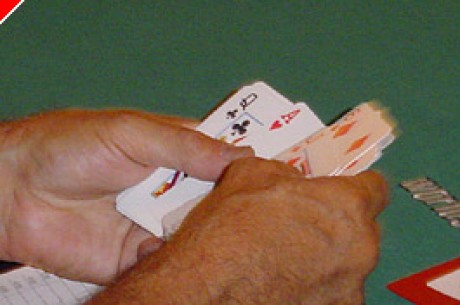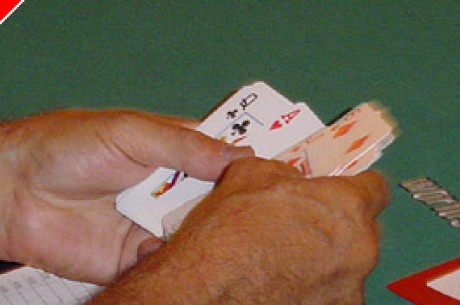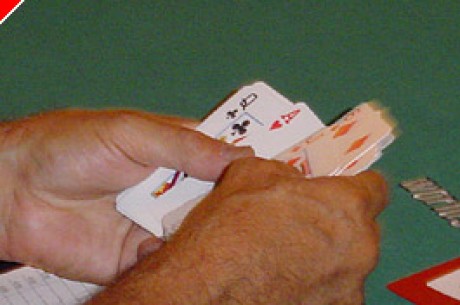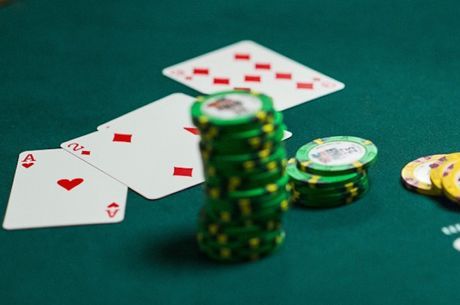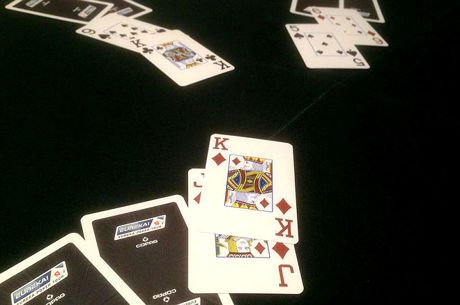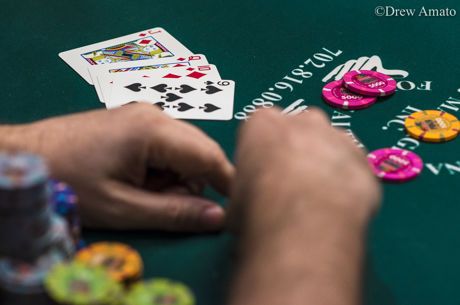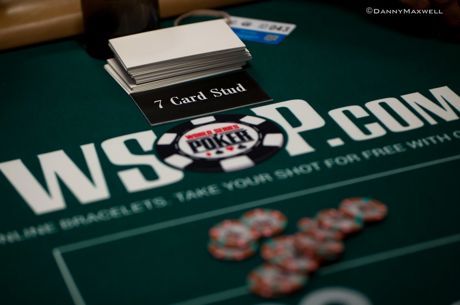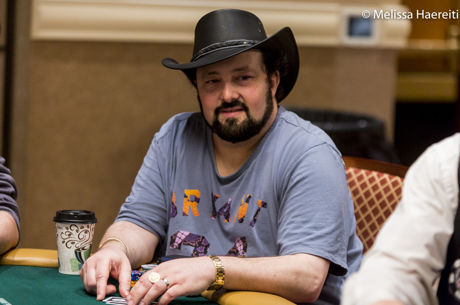Stud Poker Strategy - Big Spread Limit Games
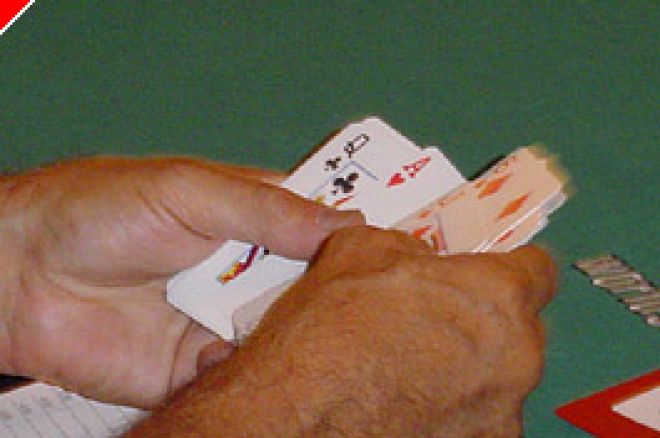
Generally speaking, there are two common varieties of 7-Card Stud games: spread limit games and the fixed limit games. Spread limit games, for the most part, tend to be very low stakes — $1-3, $1-4, or $1-5 (sometimes $2-10). The fixed limit games can generally be further divided in categories based on their stakes. There are low limit games of $1/2, $3/6 and $5/10; mid-limit games of $10/20, $15/30 and $20/40, and higher limit games of $30/60 on up. There are surely strategy differences that one can apply based on the category of the game you’re in. Roy West, David Sklansky, Mason Malmuth, Ray Zee, Mike Caro, I and a few others have written extensively about these types of games.
But there are two formats of stud that have received scant attention – primarily I suspect because they’re rarely spread in public cardrooms.. They would be Pot Limit Stud and higher stakes spread limit stud – games like $5-20 or $15-100. I’m going to devote a few columns to them here.
First of all, let’s not go crazy with this notion of different strategies for different games. Poker is still poker. Stud is still stud. I wouldn’t want you to think that the world of poker strategy is so highly specialized that you need to learn a whole now methodology for playing at every level. And, in fact, not all games with the same overall structure play similarly. You might have a $10/20 games that is a rock fest and requires the application of different strategies than an identically structured $10/20 game with four loose calling stations and three maniacs in against you.
Even so, there are some general differences in pot limit and large spread limit games that are worth considering. Let me present them to you here.
Large Spread Limit
I was fortunate enough to be invited to a great home game by a friend in Worcester. Unlike so many folks these days, he prefers limit to no limit or pot limit. And he enjoys stud. So he spread a spread limit dealer’s choice game: $5-20 spread limit. The dealer anted $5. In stud the forced bet was $5.00.
His guests and friends consisted of a couple of solid players and then a host of typical home game players – but home game players with relatively deep wallets. Most people bought in for $200. At the end of the night some won and some lost in the $1000 range.
It became clear early on that there was a built in advantage to calling flop games. As the dealer, you would retain last position in the betting. We didn’t play a full round of each game, as I do in my home games. So you’d want to call a dealer advantage game when you were the dealer. Even so, four or five of the players called 7-Card Stud. Go figure.
Players in this game, for the most part, knew enough to fold helpless hands for a full bet of $20. But they wouldn’t recognize that a flush draw, played heads up from Third Street, is surely not worth a call. So if I raised to $20 with a pair of Kings, they’d habitually call with a three flush, no matter how high or how low.
It was tempting, at times, to slow play strong Premium Pairs on Third Street. At times I did. And I’d recommend the same strategy if you’re in a game with players like these. Here’s a specific example of when you shouldn’t raise the full amount with your Premium Pair.
It’s Third Street. You’re sitting on (AhTh)As. The bring in is to your left. There is $10 in the pot. Everyone folds to you. There are two players left. One with a Ks the other with a Jc. Both are relatively loose and passive – but with your tight image they tend to play more tightly against your raises than against other players at the table.
What should you do?
Conventional 7-Card Stud strategy says that it is correct, usually, to raise – to drive these players out if you can or to force them to put more money in the pot if they want to chase.
So, typically, given the option of a call or a raise on Third Street with a pair of Aces, I nearly always raise.
But in this game you have more flexibility. Use it to your advantage. Raise a small amount, hoping to get clearly dominated hands to call you. What you want is to knock out all but one player if you can. A raise by $5.00 or $10.00 is likely to do that – especially when combined with your tight and aggressive image. You can then pound away at them on Fourth Street, regardless of whether you improve.
Compare this to a similar situation. You are sitting to the left of the bring-in and you have (KhTh)Ks. Six other players are yet to act, including one with an Ace. In this situation you would go for the largest raise possible. In this instance, unlike the other instance, you have two obstacles to clear that weren’t in front of your winning path before. You have a player with an overcard showing – who might well be tempted to call a small bet in the hope of drawing an Ace on Fourth. And you have a much larger number of people who have not yet decided to act – increasing the chances that you’ll get many calls going into Fourth. This you surely don’t want, so you want to use your betting flexibility to put maximum pressure on your opponents to fold. That means betting the maximum of $20.
In general, you use your variable betting flexibility to increase pressure on your opponents with maximum bets when you are less sure where you stand, and decreased pressure with smaller bets when you are more confident that you’ll still be in the lead on Fourth Street.
Fortunately, a variable bet can also work to your advantage because your opponents will misapply proper strategy. When they are weak they will bet less. When they are strong they will bet more. In the above instances, for example, they would be more likely to raise by $20 with the Aces and less likely to raise the full amount with Kings in early position. This allows you to broaden your spectrum of playable hands – increasing your opportunities for winning.
Let’s say, for example, that you are in late position with (JhTh)Js. An early position bettor, with an Ace, raises by $5.00. One player, with a Queen, seeing the bargain raise, calls. The action is now to you, sitting with the bring-in to your immediate left and the raiser to his immediate left.
Normally, in a structured limit game, you’d be likely to fold your lowly pair of Jacks. But in this game go ahead and call. Sure, the raiser my be slowplaying you just as you would do in his situation. Sure, the Queen may be ahead of you as well with a pair of Queens. But it’s also quite possible that the Ace has a weak hand – perhaps only Ace high, and the Queen may be sitting with relative junk as well – seduced into calling with an inferior hand because of the small raise..
But that’s not the most important reason to call. You should call even if you knew with certainty that you were against either Aces or Queens or both. That’s because of the enormous implied odds you’re getting.
Implied odds compare the current bet to the amount you may win if you hit your hand. In this case, for $5.00 you have a chance of hitting a card that could win you d to bet to stay in the hand when the amount you are likely to win well over $150-200, implied odds of 30:1 to 40:1.
What you’re hoping for is another Jack. Your odds of hitting a Jack on the next card are 20:1 (two Jacks among. Forty-two remaining unseen cards). With implied odds of 30:1 or better (depending on how many bets of $20 you can extract from your two opponents), you have a huge overlay and should call the $5.00.
In real game situations, many other factors come into play. What is the chance that you will be raised after you call? In this case none – your call will end the betting. How loose are your opponents? Are they likely to continue to call you down to the River if you raise their bet when you hit trips? Will the third best hand fold once you show aggression? You might also want to consider other ways that you could win even if you didn’t hit your perfect card on Third. What is the likelihood that the Ace will check if he doesn’t hit a card after seeing two of his opponents call? Might you be able to see Fifth Street for free, or very cheaply, if you don’t hit your hand on Fourth? If so, you can be more inclined to call the Third Street bet, since you might have two chances to hit your hand, making your drawing odds better than 20:1 and meaning that you don’t need the large implied odds for you’re your call.
All of these factors may come into play when it is a close call. But in this case, it isn’t even close. You should call the $5.00.
As you can see, a spread limit betting structure like $5-20 allows for more creative thinking and playing in stud than a strictly fixed limit structure.
Ed Note: Find all kinds of Stud games at Poker Stars sign up today.

